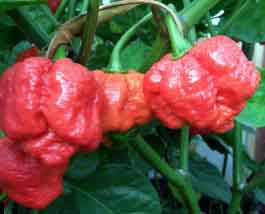 |
| Bhut jalokia chiles, rated at 1.2 million Scoville Heat Units. |
 |
| Trinidad Moruga Scorpion chile, 1.2 to 2 million Heat Unit |
 |
| Bhut Jalokia plants in November. |
I haven’t grown the Scorpion yet, but will be. My half dozen Bhut Jalokia plants are doing well, although this is not a chile pepper that likes the heat. Bhut Jalokia is native to Sri Lanka, in the mountainous tea growing region of India. It does best in cooler temperatures and so I expect, like last year, pepper production will increase considerably as fall comes on. Last year, when all my other hot peppers were over and done, the Bhuts were cranking out peppers clear into November.
This season for the first time I have encountered a pepper-wasting disease. Actually it’s related to the Verticillium wilt that affects tomatoes some years, but I seem to have encouraged it, unknowingly. I mulched my plants especially heavily with straw this year. And because the plants have looked deep green and “happy,” I thought I was doing them a great favor by watering every other day throughout the drought.
Wilting disease in peppers affects chiles that are heavily mulched, and plants that are over-watered. The plant wilts, as if it needs water, then just dies in a few days. Out of the 35 peppers, 29 of which are hot, I have lost 8 plants this year. Once I learned the problem, from an internet search, I cut back to watering only once a week, pulled back the mulch from around the plants and it seems to have slowed the progression of the disease. I’ll not plant peppers in that space next year as additional protection.
Ozarks Gardening
Copyright© Jim Long 2012
